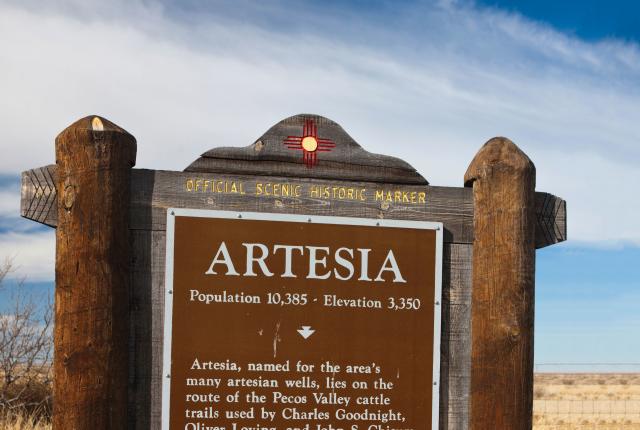ROADSIDE STOP
State Historic Marker: Artesia
Location: Eddy County, just north of Artesia, on the west side of US 285
En route to Fort Sumner and other points north, famed 19th-century cattle ranchers Charles Goodnight and Oliver Loving drove their herds past a small, cottonwood-lined spring, then called Eagle Draw. Goodnight later worked with John S. Chisum, whose South Spring Ranch rambled from Fort Sumner to Carlsbad, including Eagle Draw. Chisum’s daughter, rancher and entrepreneur Sally Chisum, sank the first successful well in the region, tapping into a large artesian water belt and driving the 1903 creation of a new townsite called Artesia.
In 1924, wildcatters found oil and gas, forever changing the town’s fortunes. Learn more at the Artesia Historical Museum and Art Center, nmmag.us/artesiamuseum. —Excerpted from Roadside New Mexico: A Guide to Historic Markers, by David Pike (UNM Press).
Explore more roadside history at nmmag.us/RoadMarks.
THE PAST IS PRESENT
New Mexico pueblos affirm their tribal sovereignty each year at the King’s Day Feast on January 6. The celebrations often mark the appointment of a new governor or war chief. Pueblos have different methods for selecting leaders: Some hold annual elections; others ask their religious leaders to make the picks. No matter how it’s decided, the transfer of power culminates with a ceremony in which three historical canes gifted by leaders from Spain, Mexico, and the United States are blessed in recognition of each pueblo’s government. Most then hold dances that are open to the public. (505) 843-7270; indianpueblo.org —Jordan Eddy
TIME TRAVEL
On January 6, 1912, at 1:35 p.m. in Washington, D.C., President Taft signed a proclamation that granted New Mexico statehood. A telegram notified Territorial Governor William J. Mills, whose daughter hoisted a new 47-star flag over the capitol building. Church bells rang all over the state.
The New Mexico Museum of Natural History opened on January 11, 1986, in Albuquerque.
Aztec Ruins National Monument opened on January 23, 1923. Its impressive Ancestral Pueblo ruins date from circa 1106.
On January 29, 1822, William Becknell returned to Franklin, Missouri, after his first trading expedition to Santa Fe. Legend has it that Spanish gold and silver coins fell from his leather pouch onto the streets, sparking a few traffic jams on the new Santa Fe Trail. —Kate Nelson


